
Vrindavan, a small town in the Indian state of Uttar Pradesh, is renowned for its spiritual significance and rich cultural heritage. Among the numerous temples that dot the landscape of this sacred town, the Radha Raman Temple stands out as one of the most revered and historically significant places of worship. In this blog, we will explore the Radha Raman Temple’s timings, entry fees, history, and the best time to plan your visit.
Radha Raman Temple Vrindavan Timings
| Day | Timing |
| Monday | 8:00 am – 12:30 pm |
| 6:00 pm – 8:00 pm | |
| Tuesday | 8:00 am – 12:30 pm |
| 6:00 pm – 8:00 pm | |
| Wednesday | 8:00 am – 12:30 pm |
| 6:00 pm – 8:00 pm | |
| Thursday | 8:00 am – 12:30 pm |
| 6:00 pm – 8:00 pm | |
| Friday | 8:00 am – 12:30 pm |
| 6:00 pm – 8:00 pm | |
| Saturday | 8:00 am – 12:30 pm |
| 6:00 pm – 8:00 pm | |
| Sunday | 8:00 am – 12:30 pm |
| 6:00 pm – 8:00 pm |
History of Radha Raman Temple Vrindavan
The Radha Raman Temple in Vrindavan boasts a history steeped in devotion and spiritual significance. This sacred temple, dedicated to Lord Krishna in His deity form as Radha Raman, is a place of profound reverence for millions of devotees worldwide. Its history is a tale of devotion and divine intervention.
The story of the Radha Raman Temple begins in the 16th century with the life of Gopala Bhatta Goswami, a prominent disciple of Lord Chaitanya Mahaprabhu, the revered saint and proponent of the Gaudiya Vaishnavism tradition. Gopala Bhatta Goswami was born into a devout Vaishnava family and was deeply drawn to the teachings of Lord Chaitanya.
The defining moment in the history of the temple is associated with a journey Gopala Bhatta Goswami undertook to Vrindavan. During his pilgrimage to the holy town, he had a profound dream. In this dream, Lord Krishna Himself appeared to him and instructed him to unearth His self-manifested deity, which was submerged in the Vrindavan area.
Upon waking, Gopala Bhatta Goswami diligently searched the area indicated in his dream. To his astonishment and joy, he discovered the deity of Radha Raman, an exquisitely carved image of Lord Krishna, made from a single piece of black marble. The deity featured Lord Krishna in His characteristic pose playing the flute, with Radha by His side.
This discovery was seen as a divine revelation, and Gopala Bhatta Goswami, overwhelmed with devotion, established the Radha Raman Temple to enshrine this divine manifestation. The temple was constructed with great care and adorned with intricate architectural details, creating an ambiance of spiritual splendor.
The Radha Raman Temple’s history is not just about its establishment but also about the unbroken tradition of worship that has continued for centuries. The temple’s daily rituals, ceremonies, and festivals are conducted with utmost devotion, and the deity of Radha Raman is venerated as the living presence of Lord Krishna.
The temple’s history is a testament to the power of faith and divine guidance. It stands as a symbol of unwavering devotion and is a pilgrimage site where devotees seek a closer connection with Lord Krishna through the worship of Radha Raman.
Today, the Radha Raman Temple remains one of the most revered and visited shrines in Vrindavan, attracting devotees and tourists from all corners of the world. Its history continues to inspire and captivate the hearts of those who seek spiritual solace and divine blessings in the sacred land of Vrindavan.
Image Gallery of Radha Raman Temple Vrindavan
Radha Raman Temple Vrindavan Aarti Timings
| Summer | Winter |
| Mangal Aarti 4:00 am | Mangal Aarti 5:30 am |
The Radha Raman Temple in Vrindavan conducts daily aarti ceremonies to mark different parts of the day. The timings for the Mangla Aarti, which is the early morning aarti, vary between winter and summer:
- Mangla Aarti in Winter:
- Timing: 4:00 AM
- Mangla Aarti in Summer:
- Timing: 5:30 AM
These aarti ceremonies are an integral part of the temple’s daily rituals, and they create a spiritually charged atmosphere for devotees and visitors. It’s important to note that the timings may be adjusted slightly based on specific dates, so it’s a good idea to confirm the exact schedule with the temple authorities or the temple’s official website if you plan to attend the aarti.
Things to do at Radha Raman Temple Vrindavan
Vrindavan, a town in the heart of India, is synonymous with spirituality and devotion. It’s a place where the air is filled with the essence of Lord Krishna, and every corner resonates with the divine. Among the many temples in Vrindavan, the Radha Raman Temple stands as a beacon of faith and a testament to the rich spiritual heritage of the region. This article is your guide to exploring the various activities and experiences you can immerse yourself in when you visit the Radha Raman Temple.
1. Darshan of Lord Radha Raman
The primary reason for visiting the Radha Raman Temple is to have darshan, a glimpse, of the deity, Lord Radha Raman. The temple’s sanctum sanctorum houses the exquisitely carved deity of Lord Krishna, known for His enchanting smile and divine aura.
2. Witness Daily Aarti
Participating in the daily aarti (ritual of offering lamps) at the temple can be a deeply spiritual experience. The aarti is performed multiple times a day, and it’s a moment when the devotees come together to offer their prayers and gratitude to the Lord.
3. Partake in Bhajans and Kirtans
The temple often resonates with the melodious sounds of bhajans (spiritual songs) and kirtans (devotional chants). Joining these musical sessions can elevate your spiritual experience and connect you with the devotion that fills the temple’s ambiance.
4. Explore Temple Architecture
Take time to appreciate the intricate architecture of the Radha Raman Temple. The temple is known for its stunning marble work, detailed carvings, and overall design that reflects the rich cultural heritage of the region.
5. Visit the Samadhi of Gopala Bhatta Goswami
Adjacent to the main temple, you’ll find the samadhi (final resting place) of Gopala Bhatta Goswami, the saint who founded the temple. Pay your respects to this revered soul, whose divine vision led to the establishment of the temple.
6. Engage in Seva (Service)
Many visitors find fulfillment in engaging in seva, or voluntary service, at the temple. Whether it’s helping with cleaning, decorating, or distributing prasadam (sanctified food) to devotees, seva allows you to be an active part of the temple’s activities.
7. Attend Spiritual Discourses
The Radha Raman Temple often organizes spiritual discourses and lectures on topics related to Hindu philosophy and devotion. These sessions provide valuable insights into the spiritual teachings and traditions of the temple.
8. Make Donations or Contributions
You can contribute to the temple’s charitable activities by making donations. These contributions are used for the maintenance of the temple and for supporting various social initiatives undertaken by the temple authorities.
9. Enjoy Prasadam
After your visit, don’t forget to partake in the prasadam offered at the temple. Prasadam is considered sacred food, blessed by the deity, and it’s a delightful way to conclude your visit.
10. Photography
Capture the temple’s beauty and the moments of devotion through photography. However, be respectful of the temple’s rules and the privacy of worshippers while doing so.
11. Silent Meditation
The peaceful atmosphere of the Radha Raman Temple makes it an ideal place for meditation and introspection. Find a quiet corner, sit, and meditate, allowing yourself to connect with the divine presence.
12. Explore Nearby Temples
Vrindavan is home to many other famous temples and holy sites. You can extend your spiritual journey by exploring nearby temples like the Banke Bihari Temple, ISKCON Temple, and Prem Mandir.
13. Seek Blessings
Don’t hesitate to seek the blessings of the temple priests. They often perform special blessings and rituals that can bring a sense of peace and prosperity to your life.
14. Immerse in Festivals
If your visit coincides with a festival, such as Janmashtami (Lord Krishna’s birthday) or Radhastami (Radha’s appearance day), immerse yourself in the grand celebrations and experience the joyous fervor of the devotees.
15. Purchase Souvenirs
Before leaving, you can shop for souvenirs and mementos from the temple’s gift shop. These items often include spiritual books, idols, and clothing that serve as reminders of your spiritual journey.
Visiting the Radha Raman Temple in Vrindavan is not merely a tourist experience; it’s a spiritual sojourn that allows you to immerse yourself in the devotion and culture of this sacred place. Whether you are a devout follower or a curious traveler, the temple offers a profound and memorable experience.
Timings of Radha Raman Temple
The Radha Raman Temple in Vrindavan follows specific timings for darshan (viewing of the deity) and various rituals. As of the available information, here are the timings of the Radha Raman Temple:
- Morning Darshan:
- Timing: 8:00 AM to 12:30 PM
- Evening Darshan:
- Timing: 6:00 PM to 8:00 PM
Please note that these timings may be subject to change, especially during special festivals and occasions. It’s advisable to check with the temple authorities or visit the official website of the Radha Raman Temple for any updates or changes in the schedule before planning your visit.
Radha Raman Temple Vrindavan Entry Fee
Thankfully, there is no entry fee to visit the Radha Raman Temple. It is open to all devotees and tourists, regardless of their background or beliefs. Donations are accepted, and contributions to the temple’s maintenance and charitable activities are always appreciated.
The architecture of Radha Raman Temple Vrindavan
The architecture of the Radha Raman Temple in Vrindavan is a splendid blend of intricate craftsmanship, devotion, and spiritual symbolism. This temple, dedicated to Lord Krishna in His deity form as Radha Raman, showcases a unique architectural style that reflects the rich heritage of Vrindavan and the devotion of its founders.
Here, we delve into the architectural marvels that define the Radha Raman Temple.
1. Marble Marvel: The Radha Raman Temple is predominantly constructed using pristine white marble, which imparts an ethereal and divine ambiance. The use of marble not only enhances the temple’s visual appeal but also symbolizes purity and spirituality in Hindu architecture.
2. Intricate Carvings: The temple is renowned for its elaborate carvings that adorn its walls, pillars, and spires. These carvings depict scenes from the life of Lord Krishna, various incarnations, and mythological stories from Hindu scriptures. Every detail is meticulously crafted, showcasing the skill and dedication of the artisans.
3. Shikhara (Spire): The temple’s shikhara, or spire, is an architectural marvel in itself. Rising gracefully above the temple, it features intricate floral motifs and sculptures of deities. The shikhara symbolizes the ascent of the soul towards the divine.
4. Lotus Dome: At the top of the shikhara, you’ll find a lotus-shaped dome, a recurring motif in Hindu architecture symbolizing purity and divine beauty. The dome’s design is both aesthetically pleasing and spiritually significant.
5. Inner Sanctum: The sanctum sanctorum, where the deity Radha Raman is enshrined, is a masterpiece of craftsmanship. The inner sanctum is adorned with silver-plated doors, and the deity is situated behind a beautifully crafted silver altar. Devotees often marvel at the deity’s exquisite attire and jewelry.
6. Jharokhas (Balconies): The Radha Raman Temple features intricately designed jharokhas or balconies that provide stunning views of the temple complex and the surrounding area. These balconies are not just architectural elements but also serve as vantage points for devotees and visitors.
7. Pillars and Corridors: The temple’s corridors and pillars are adorned with ornate designs, showcasing a seamless fusion of artistic aesthetics and spiritual motifs. These corridors provide shelter to devotees and create a serene atmosphere for prayer and meditation.
8. Rajasthani Influence: The temple’s architectural style draws inspiration from Rajasthani architecture, characterized by its ornate patterns, intricate details, and use of marble. This fusion of regional styles adds to the temple’s unique charm.
9. Courtyards and Gardens: The temple complex includes well-maintained courtyards and gardens, offering a peaceful and green oasis amidst the hustle and bustle of Vrindavan. These outdoor spaces complement the temple’s architecture, creating a harmonious environment.
10. Renovations and Preservation: Over the centuries, the Radha Raman Temple has undergone renovations and restoration efforts to preserve its architectural glory. The temple management takes great care to maintain its original design and ensure its longevity.
Radha Raman Temple’s architecture is a testament to the devotion and craftsmanship of its founders and artisans. It not only serves as a place of worship but also stands as an architectural wonder that continues to inspire and captivate visitors from around the world.
Importance of the Radha Raman Temple Vrindavan
The Radha Raman Temple in Vrindavan holds immense importance in Hinduism and is revered by devotees and pilgrims for several compelling reasons:
- Deity of Lord Radha Raman: The primary significance of the Radha Raman Temple lies in its deity, Lord Radha Raman. Lord Krishna, in His deity form as Radha Raman, is the central deity of the temple. This form of Krishna is particularly special because it is believed that Gopala Bhatta Goswami, the temple’s founder, received this self-manifested deity directly from Lord Krishna. Devotees come to seek blessings and have darshan (viewing) of Radha Raman, believing that His grace can bring spiritual elevation and liberation.
- Spiritual Heritage: The temple stands as a historic and cultural treasure, symbolizing the rich spiritual heritage of Vrindavan. It is one of the most ancient temples in the town, tracing its origins back to the 16th century when Gopala Bhatta Goswami established it. The temple has preserved the traditions and teachings of the Gaudiya Vaishnavism school of thought, which emphasizes devotion to Lord Krishna.
- Divine Intervention: The story of the temple’s establishment involves a divine intervention. Gopala Bhatta Goswami had a dream in which Lord Krishna instructed him to unearth the deity of Radha Raman from the Vrindavan area. This divine revelation adds to the temple’s significance as a place where the Lord Himself guided its creation.
- Spiritual Pilgrimage: Vrindavan, as a whole, is considered a sacred pilgrimage site, and the Radha Raman Temple is one of its crown jewels. Devotees and tourists visit this temple as part of their spiritual journey to connect with Lord Krishna’s divine pastimes and teachings. The temple provides a serene and spiritually charged environment for meditation and devotion.
- Cultural and Architectural Marvel: The temple’s architectural beauty is a sight to behold. Its intricate marble work, detailed carvings, and Rajasthani-inspired design make it an architectural marvel. The temple’s stunning architecture is not only visually appealing but also symbolically significant, representing the soul’s journey towards the divine.
- Daily Rituals and Festivals: The Radha Raman Temple is a hub of daily rituals and ceremonies that attract devotees and visitors. The aarti (ceremonial worship with lamps) performed multiple times a day creates an atmosphere of devotion and reverence. Additionally, the temple celebrates various festivals, such as Janmashtami (Lord Krishna’s birthday) and Radhastami (Radha’s appearance day), with grandeur and fervor.
- Community and Service: The temple serves as a focal point for the local community, offering services and support to those in need. It engages in charitable activities, including feeding the hungry and providing education to underprivileged children. This sense of service adds a layer of significance to the temple beyond its religious aspects.
- Tourism and Cultural Exchange: The Radha Raman Temple also plays a crucial role in promoting tourism and cultural exchange. It attracts visitors from all over the world, providing them with an opportunity to learn about Hinduism, Indian spirituality, and the cultural diversity of the country.
Radha Raman Temple in Vrindavan is not merely a place of worship but a symbol of devotion, spirituality, history, and culture. It holds a special place in the hearts of devotees and serves as a timeless testament to the enduring legacy of Lord Krishna’s divine presence in Vrindavan.
Interesting Facts about Radha Raman Temple Vrindavan
The Radha Raman Temple in Vrindavan is a place rich in history and spirituality. Beyond its religious significance, there are several fascinating and interesting facts associated with this revered temple:
- Self-Manifested Deity: One of the most intriguing aspects of the Radha Raman Temple is its deity, Lord Radha Raman. It is believed that this deity is self-manifested, meaning it was not crafted by human hands. According to legend, Gopala Bhatta Goswami, the temple’s founder, received this deity directly from Lord Krishna in a dream.
- One-Piece Deity: The deity of Radha Raman is carved out of a single piece of black marble. This makes it a remarkable and unique piece of artistry. The intricate details and craftsmanship on this deity are awe-inspiring.
- The “Rasacharya” Founder: Gopala Bhatta Goswami, who established the Radha Raman Temple, is known as a “Rasacharya.” He was renowned for his deep understanding of the rasas (spiritual emotions) in Krishna’s pastimes and for his exceptional devotion.
- Daily 7:00 AM Abhishek: One of the daily rituals at the temple that draws devotees is the abhishek (ritual bathing) of the deity, which takes place at 7:00 AM. Devotees often gather to witness this sacred ceremony, where the deity is bathed with various substances like milk, ghee, honey, and water.
- Tulsi Leaves as Prasadam: The temple is known for distributing prasadam (sanctified food) in the form of tulsi leaves. It is believed that Lord Radha Raman has a special affinity for tulsi, and offering these leaves to Him is considered highly auspicious.
- Emphasis on Bhakti: The Radha Raman Temple is closely associated with the Bhakti (devotion) movement in India. It follows the teachings of Lord Chaitanya Mahaprabhu, who emphasized the importance of bhakti in attaining spiritual realization.
- Unique Samadhi: Adjacent to the main temple, you’ll find the samadhi (final resting place) of Gopala Bhatta Goswami, the temple’s founder. It’s a serene and spiritually charged spot where devotees pay their respects to this great saint.
- Rathayatra Festival: The Radha Raman Temple celebrates the Rathayatra festival with great enthusiasm. During this festival, a grand chariot procession takes place, where the deity of Lord Radha Raman is taken out for a public procession through the streets of Vrindavan.
- Renowned for Music: The temple is known for its devotional music, including bhajans (spiritual songs) and kirtans (devotional chants). These musical renditions add to the spiritual ambiance of the temple and draw devotees from far and wide.
- Community Service: In addition to its religious activities, the Radha Raman Temple is actively involved in community service. It operates educational institutions, provides food to the needy, and engages in various charitable initiatives.
- Spiritual Retreat: Many people visit the Radha Raman Temple seeking a spiritual retreat. Its serene and peaceful environment, away from the hustle and bustle of city life, makes it an ideal place for meditation and introspection.
- Global Pilgrimage: The temple attracts devotees and tourists from all over the world, making it a global pilgrimage site. People from different cultures and backgrounds come to seek spiritual solace and experience the divine presence of Lord Radha Raman.
These interesting facts about the Radha Raman Temple in Vrindavan shed light on the temple’s unique history, traditions, and spiritual significance, making it a place of wonder and reverence for all who visit.
Festivals at Radha Raman Temple Vrindavan
Vrindavan, the land of Lord Krishna’s childhood exploits, is a place where devotion and festivity go hand in hand. Among the many temples that grace this sacred town, the Radha Raman Temple stands out not only for its spiritual significance but also for its vibrant and joyous festivals. In this article, we’ll explore the enchanting festivals celebrated at the Radha Raman Temple in Vrindavan, where every moment is a celebration of love and devotion.
1. Janmashtami – Celebrating Lord Krishna’s Birth
Janmashtami, the birthday of Lord Krishna, is one of the most significant festivals at the Radha Raman Temple. Devotees from all over the world gather here to witness the grand celebrations. The temple is beautifully adorned, and the main event is the midnight aarti, marking the exact moment of Lord Krishna’s birth. The atmosphere is filled with devotion, as devotees sing bhajans and chant Krishna’s name.
2. Radhastami – Honoring the Divine Feminine
Radhastami, the appearance day of Radha, Lord Krishna’s eternal consort, is another important festival. Devotees celebrate the divine love between Radha and Krishna with great fervor. Special aartis, kirtans, and processions are organized to honor Radha’s role in Krishna’s pastimes.
3. Holi – The Festival of Colors
Holi in Vrindavan is legendary, and the Radha Raman Temple is no exception. The temple comes alive with vibrant colors and festivities. Devotees and visitors alike participate in the joyful revelry, throwing colored powders and water at each other. It’s a day of unity and merriment, symbolizing the playful spirit of Lord Krishna.
4. Rathayatra – Chariot Procession
The Rathayatra festival at the Radha Raman Temple is a spectacle to behold. A grand chariot procession carries the deities of Radha Raman and other prominent deities through the streets of Vrindavan. Devotees pull the chariot with immense devotion, and the air resounds with the chanting of Krishna’s holy names.
5. Gopashtami – Celebrating Krishna as a Cowherd
Gopashtami commemorates the day when a young Lord Krishna was granted permission to herd the cows. At the Radha Raman Temple, this festival is marked by special pujas and rituals dedicated to Lord Krishna’s role as a cowherd.
6. Goverdhan Puja – Worship of the Govardhan Hill
Goverdhan Puja is a festival that pays homage to the Govardhan Hill, lifted by Lord Krishna to protect the residents of Vrindavan from Lord Indra’s wrath. Devotees create miniature hills from cow dung and worship them, symbolizing their gratitude to Lord Krishna’s divine protection.
7. Annakut – The Mountain of Food
Annakut, meaning “mountain of food,” is celebrated with great enthusiasm at the Radha Raman Temple. Devotees prepare a lavish feast of vegetarian dishes and offer them to the deity. This festival marks the bond between Lord Krishna and food, signifying the importance of nourishment.
8. Kartik – A Month of Devotion
The month of Kartik holds special significance at the Radha Raman Temple. Devotees observe various rituals, offer lamps, and engage in extra devotional practices throughout this auspicious month. It is believed that the spiritual benefits of devotion are multiplied during Kartik.
9. Nityananda Trayodashi – Celebrating Lord Nityananda
Nityananda Trayodashi honors Lord Nityananda, an incarnation of Lord Balarama and an eternal associate of Lord Krishna. Devotees gather to sing kirtans, offer special prayers, and remember Lord Nityananda’s mercy.
The Radha Raman Temple in Vrindavan is not only a place of worship but also a hub of vibrant and spiritually charged festivals. These celebrations bring together devotees and visitors from all walks of life, uniting them in the love and devotion for Lord Krishna and Radha. Each festival is a testimony to the enduring legacy of devotion in the land of Vrindavan.
Timings of Radha Raman Temple Vrindavan
The Radha Raman Temple in Vrindavan, India, is not only a place of profound spiritual significance but also a sanctuary of divine experiences. To ensure that devotees and visitors have the opportunity to connect with the divine, the temple follows a set schedule of timings. In this article, we’ll explore the timings of the Radha Raman Temple, allowing you to plan your visit and make the most of your spiritual journey.
1. Mangala Aarti – Embracing the Dawn
- Timings: Approximately 4:30 AM
- Description: The day at the Radha Raman Temple begins with the Mangala Aarti, a sacred ritual that ushers in the dawn. Devotees gather in the early hours to witness this spiritual awakening, where lamps are lit, prayers are offered, and the temple’s ambiance is filled with divine energy.
2. Morning Darshan – A Glimpse of the Divine
- Timings: From 4:30 AM to 12:00 PM
- Description: After the Mangala Aarti, the temple opens its doors for devotees to have a darshan (viewing) of Lord Radha Raman. This morning darshan provides an opportunity for devotees to offer their prayers and seek the blessings of the deity.
3. Temple Closure – A Midday Break
- Timings: From 12:00 PM to 4:00 PM
- Description: The Radha Raman Temple usually closes for a few hours in the afternoon. During this break, temple maintenance is carried out, and preparations are made for the evening ceremonies.
4. Evening Darshan – Reverence at Dusk
- Timings: From 4:00 PM to 8:00 PM
- Description: The evening darshan resumes in the late afternoon, allowing devotees to once again have darshan of Lord Radha Raman. The temple’s atmosphere becomes serene and spiritually charged as devotees gather for their evening prayers.
5. Sandhya Aarti – Illuminating the Evening
- Timings: Approximately 7:00 PM
- Description: The Sandhya Aarti, or evening aarti, is a significant ritual that takes place around 7:00 PM. It involves the offering of lamps and prayers to the deity, creating a sacred and luminous atmosphere within the temple.
6. Shayan Aarti – Lord’s Retiring Hour
- Timings: Around 8:00 PM
- Description: The Shayan Aarti, the final aarti of the day, marks the time when Lord Radha Raman retires for the night. After this aarti, the temple is closed for the day, concluding the daily schedule of activities.
Please note that these timings are approximate and may vary on specific festival days or during special occasions. It’s advisable to check with the temple authorities or visit the official website of the Radha Raman Temple for any updates or changes in the schedule, especially if you plan to visit during festivals or special events.
Radha Raman Temple’s timings are designed to provide devotees and visitors with ample opportunities to connect with the divine, experience the temple’s spiritual ambiance, and partake in the rituals and ceremonies that make this sacred place a beacon of devotion in Vrindavan. Whether you are a devout follower or a curious traveler, these timings allow you to immerse yourself in the spiritual journey that the temple offers.
Places to Visit Near Radha Raman Temple Vrindavan
Vrindavan, a town steeped in spirituality and the divine, is not only home to the enchanting Radha Raman Temple but also offers a plethora of other sacred and picturesque places to explore. If you’re planning a visit to the Radha Raman Temple in Vrindavan, consider extending your journey to discover the nearby gems that resonate with the same spiritual energy. In this article, we’ll take you on a virtual tour of the places to visit near Radha Raman Temple, offering a holistic experience of this sacred town.
Banke Bihari Temple:
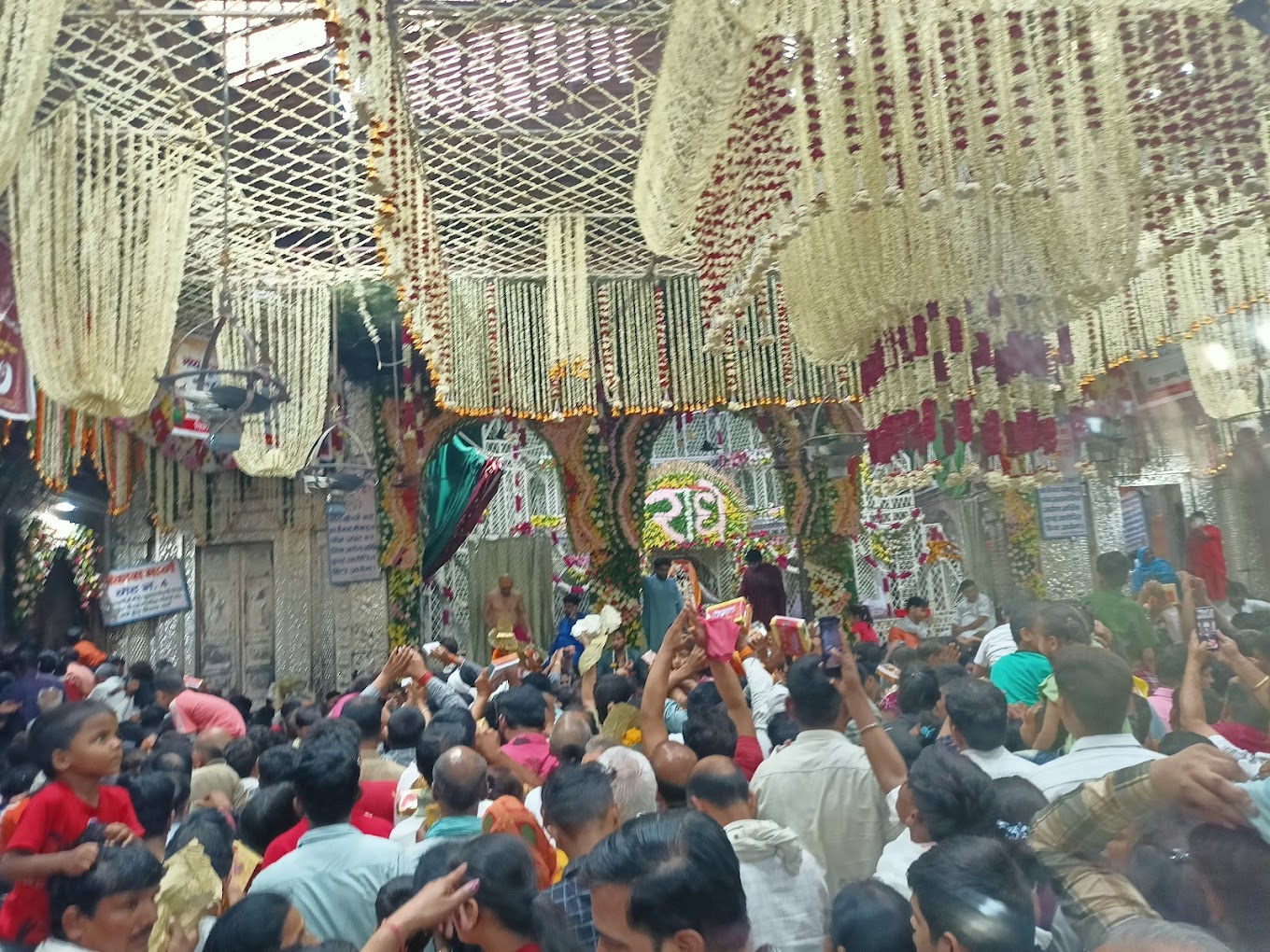
Located just a short distance from Radha Raman Temple, the Banke Bihari Temple is dedicated to Lord Krishna in His child form. The temple is famous for its unique tradition of the deity appearing with swinging motions, and it attracts a large number of devotees.
ISKCON Temple (Krishna Balaram Mandir):

The International Society for Krishna Consciousness (ISKCON) Temple in Vrindavan is a magnificent complex dedicated to Lord Krishna and His teachings. It features beautiful architecture, a serene environment, and a museum showcasing the life and teachings of Lord Krishna.
Prem Mandir:
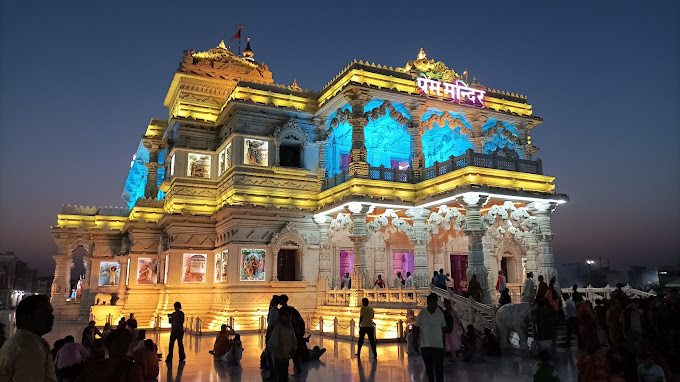
Prem Mandir is a stunning temple dedicated to Radha and Krishna. It’s known for its exquisite marble work and vibrant lighting that creates a mesmerizing visual spectacle during the evening. The temple premises also include beautiful gardens.
Radha Vallabh Temple:
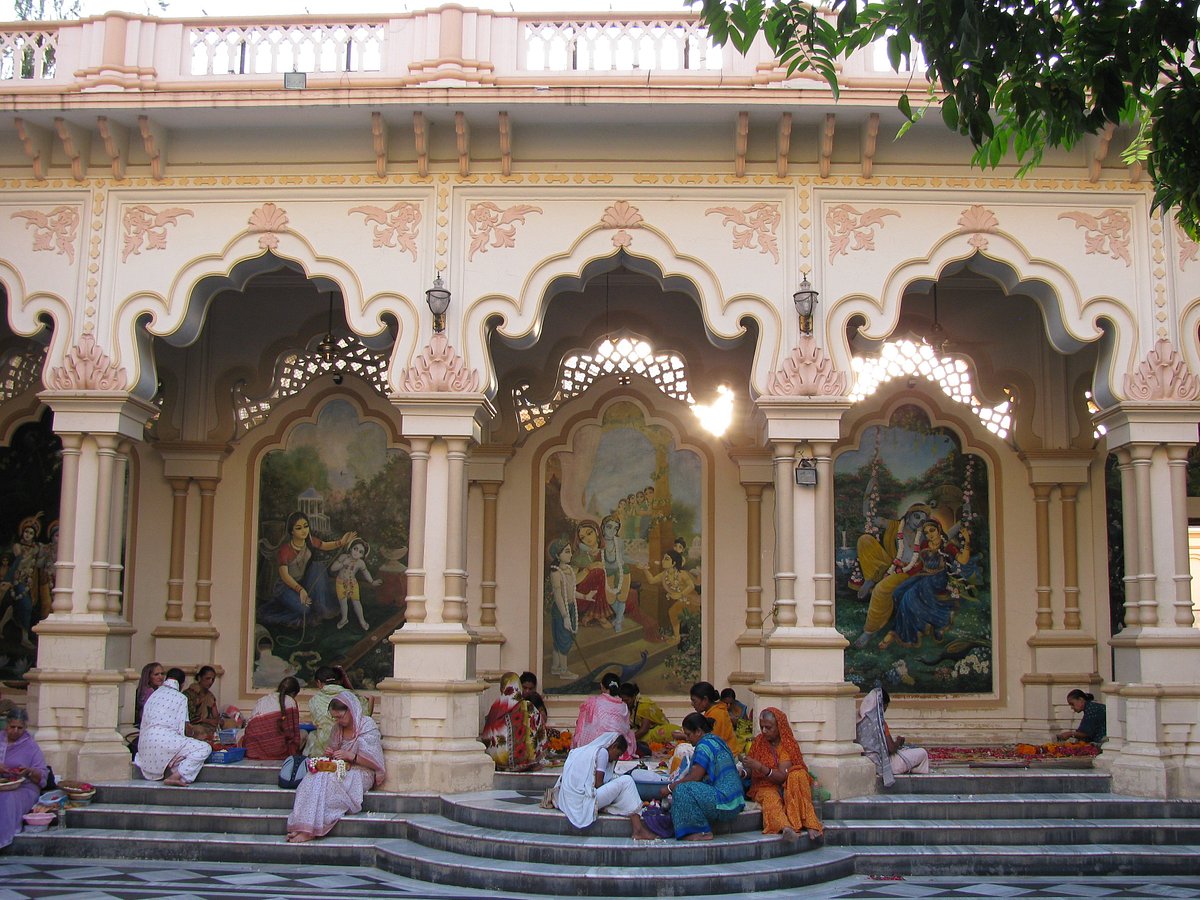
This ancient temple, dedicated to Radha Vallabh (Lord Krishna), is known for its intricate architecture and the deity’s unique appearance, where the eyes of Lord Krishna are said to follow you wherever you go.
Keshi Ghat:

Keshi Ghat is one of the 12 principal ghats along the Yamuna River in Vrindavan. It is believed to be the place where Lord Krishna subdued the demon horse, Keshi. The ghat is a tranquil spot for a holy dip and meditation.
Govind Dev Temple:
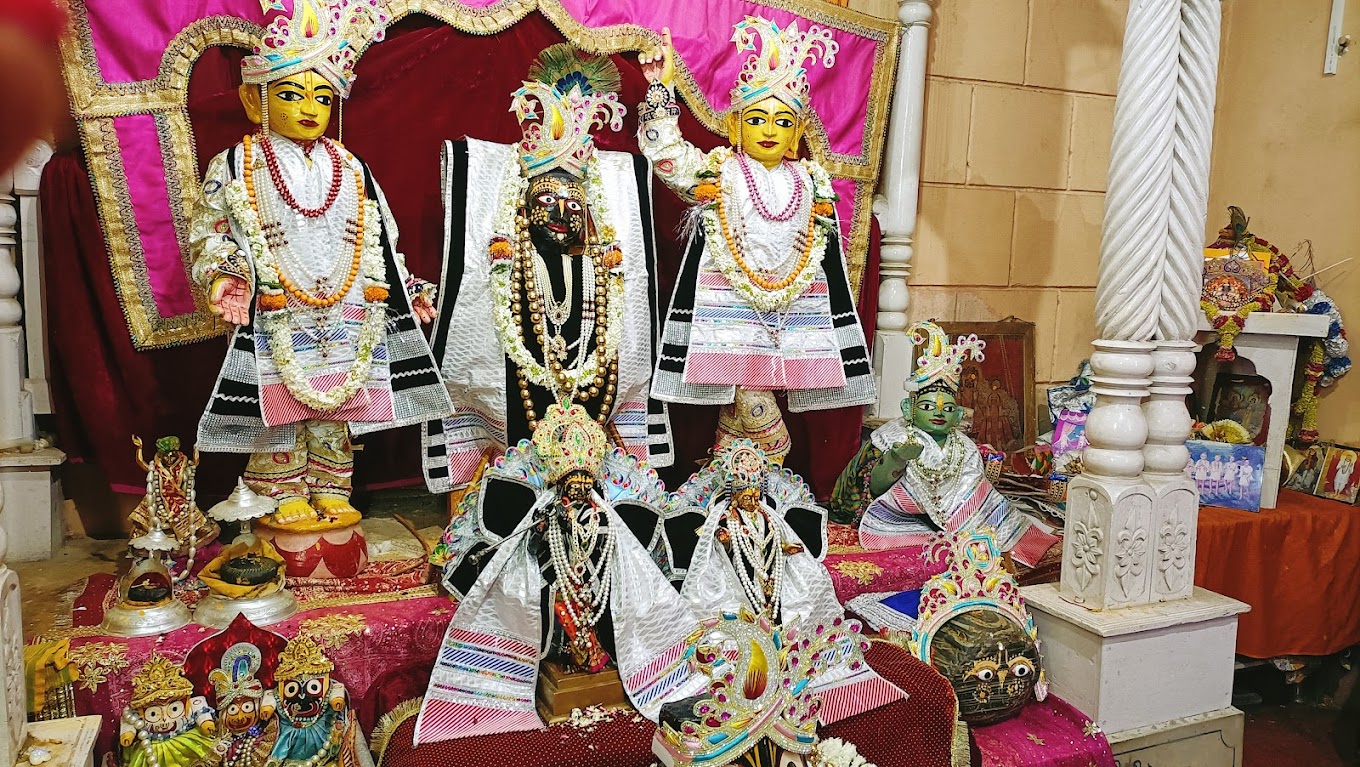
This temple is a replica of the original Govind Dev Temple in Jaipur, Rajasthan. It houses a deity of Lord Krishna and is a marvel of Rajasthani architecture. The temple also hosts cultural performances and events.
Seva Kunj and Nidhuban:
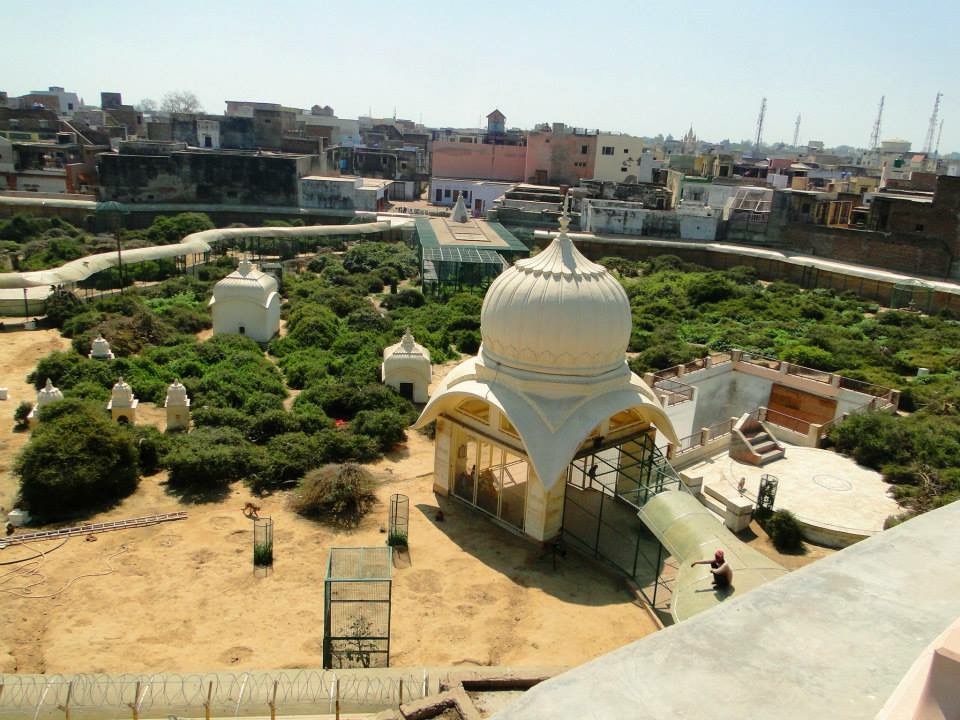
These lush gardens are believed to be the sites where Lord Krishna performed various pastimes with Radha and the gopis. Devotees visit to experience the divine love and devotion associated with these places.
Madan Mohan Temple:
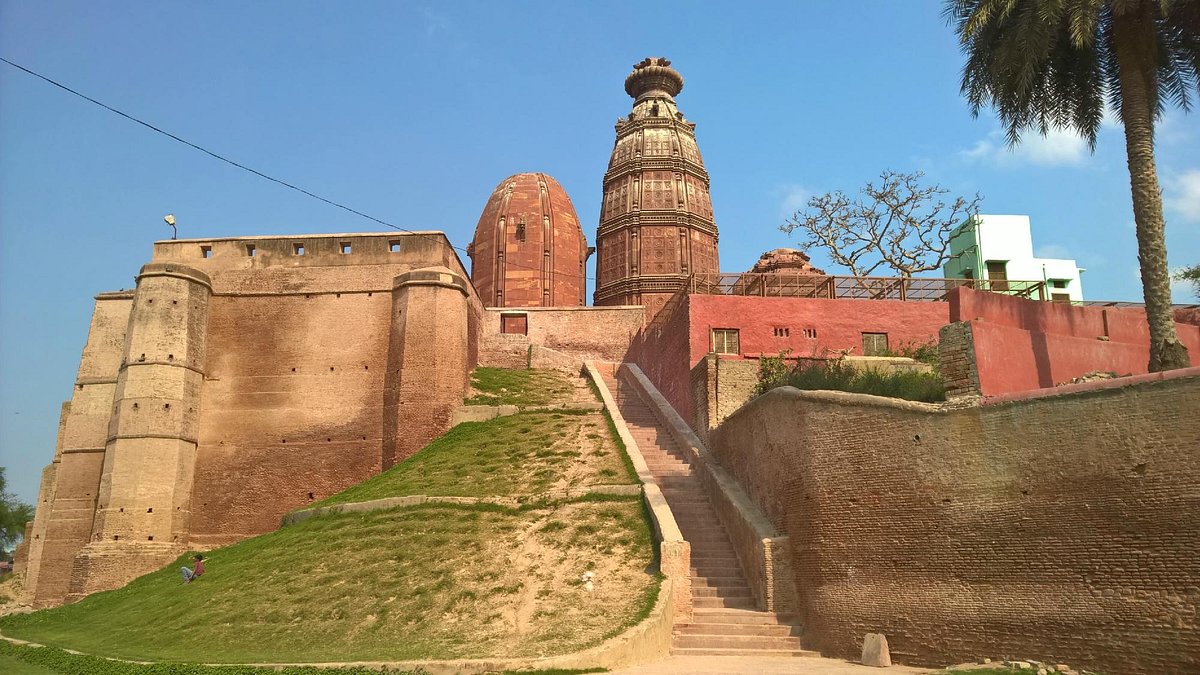
The Madan Mohan Temple is one of the oldest temples in Vrindavan and is dedicated to Lord Krishna. It’s known for its architectural elegance and spiritual significance.
Sri Ranganatha Temple:
This temple is a South Indian-style temple dedicated to Lord Ranganatha (a form of Lord Vishnu). It’s a unique contrast to the North Indian architectural styles prevalent in Vrindavan.
Yamuna Riverfront:
A visit to Vrindavan is incomplete without a peaceful stroll along the Yamuna Riverfront. You can take in the serene views of the river and witness the spiritual activities that take place along its banks.
Pagal Baba Temple:
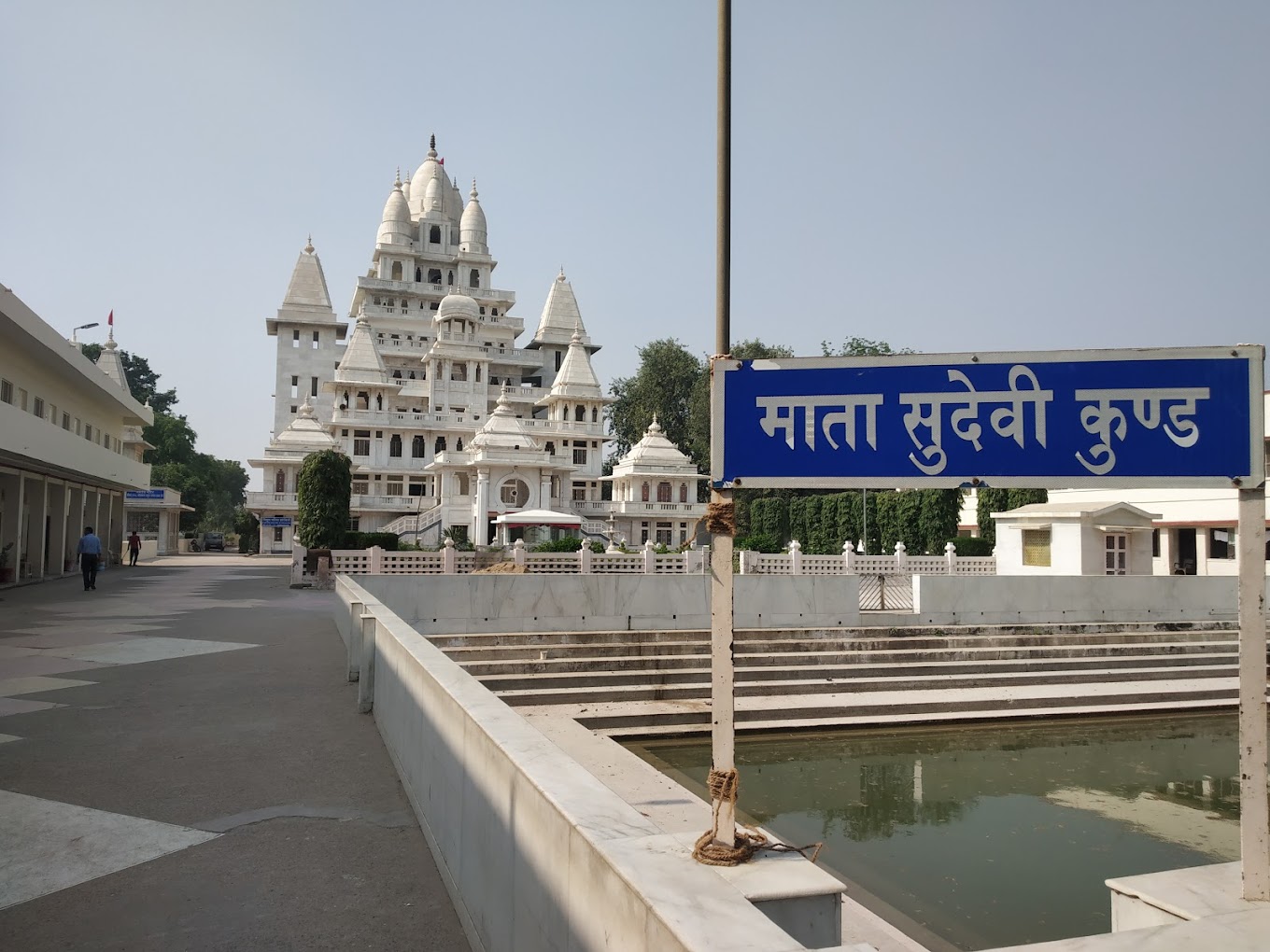
This temple is dedicated to Lord Shiva and is known for its unique tradition of offering bhang (a cannabis-infused drink) to the deity. It’s an intriguing place for those interested in local customs and rituals.
Vrindavan Chandrodaya Mandir:

Under construction, this temple is set to become the tallest temple in the world when completed. It will feature a panoramic view of Vrindavan and various cultural and spiritual attractions.
These are just a few of the many places to explore near the Radha Raman Temple in Vrindavan. Each site is imbued with spirituality, history, and the enduring legacy of Lord Krishna’s divine presence in this sacred town.
Best Time to Visit Radha Raman Temple Vrindavan
Vrindavan, a place where the air is filled with devotion and the streets resonate with the chants of Lord Krishna’s name, is a destination that beckons spiritual seekers and travelers alike. Among the numerous sacred sites in Vrindavan, the Radha Raman Temple stands as a radiant gem. If you’re planning a visit to this temple town, you might wonder when the best time to immerse yourself in its divine aura is. Let’s explore the seasons and occasions that make Vrindavan and the Radha Raman Temple come alive.
Embracing the Seasons
1. Autumn (October to November):
- Weather: Pleasant temperatures and clear skies.
- Festivals: Diwali and Govardhan Puja are celebrated with grandeur during this season, adorning the temple with lights and colors. It’s a time of joy and devotion.
2. Winter (December to February):
- Weather: Cool and comfortable, ideal for outdoor exploration.
- Festivals: The tranquil winter months offer a serene atmosphere for introspection and spiritual connection. Christmas and New Year’s celebrations add to the charm.
3. Spring (February to March):
- Weather: Spring brings blooming flowers and a pleasant climate.
- Festivals: Holi, the festival of colors, is celebrated with unmatched enthusiasm. It’s a visual and spiritual delight to witness.
4. Summer (April to June):
- Weather: Hot and dry, but early April can still be bearable.
- Advantages: Fewer crowds, making it suitable for a quieter visit and contemplation.
5. Monsoon (July to September):
- Weather: Lush greenery and occasional heavy rainfall.
- Advantages: Experience the romantic monsoon charm, but be prepared for rain-related disruptions.
Special Occasions and Festivals
1. Janmashtami (August):
- Significance: Lord Krishna’s birthday.
- Atmosphere: The temple is adorned with grand decorations and celebrations. It’s a vibrant time to witness the devotion of thousands.
2. Radhastami (September):
- Significance: Radha’s appearance day.
- Atmosphere: Devotees celebrate Radha’s divine love for Lord Krishna with devotion and rituals.
Weekdays vs. Weekends
1. Weekdays:
- Advantages: Fewer visitors, offering a more tranquil and personal experience.
2. Weekends:
- Advantages: Vibrant with devotees and tourists, creating a lively atmosphere.
The best time to visit Radha Raman Temple in Vrindavan largely depends on your preferences. If you seek vibrant festivals and cultural experiences, plan your visit during Janmashtami, Holi, or other significant celebrations. For a peaceful and introspective visit, weekdays during autumn or winter are ideal. Ultimately, Vrindavan and Radha Raman Temple are a testament to timeless devotion, and any time you choose to visit will provide an opportunity for spiritual growth and reflection.
How to Reach Radha Raman Temple Vrindavan
Reaching the Radha Raman Temple in Vrindavan is a straightforward journey, and there are multiple transportation options available for travelers.
Here’s a guide on how to reach Radha Raman Temple:
By Air:
1. Indira Gandhi International Airport (DEL): The nearest major airport to Vrindavan is the Indira Gandhi International Airport in New Delhi, which is approximately 150 kilometers away. From the airport, you have several options:
- Private Taxi: You can hire a private taxi or cab from the airport to Vrindavan. It’s a convenient but relatively expensive option.
- Public Transportation: You can take a taxi or a shuttle service from the airport to New Delhi Railway Station and then proceed to Vrindavan by train or bus.
By Train:
2. Mathura Junction Railway Station: Mathura is the nearest railway station to Vrindavan, located just about 10 kilometers away. Mathura Junction is well-connected to major cities in India. From Mathura, you have a few options to reach Radha Raman Temple:
- Auto Rickshaw/Taxi: You can hire an auto-rickshaw or taxi to reach Vrindavan. The journey takes approximately 30 minutes.
- Local Buses: Local buses also run between Mathura and Vrindavan at regular intervals.
By Road:
3. Roadways: Vrindavan is well-connected by road to various cities and towns in North India. Here are some common ways to reach Vrindavan by road:
- Delhi to Vrindavan: The distance between Delhi and Vrindavan is around 150 kilometers, and the journey takes approximately 3-4 hours by car. You can take the Yamuna Expressway for a smoother drive.
- Agra to Vrindavan: Agra is approximately 75 kilometers away from Vrindavan, and you can reach Vrindavan in around 2 hours by car.
- Mathura to Vrindavan: If you are coming from Mathura, you can easily reach Vrindavan by taxi, auto-rickshaw, or local bus.
- Jaipur to Vrindavan: The distance between Jaipur and Vrindavan is about 220 kilometers, and the journey takes around 4-5 hours by car.
Local Transportation:
Once you reach Vrindavan, getting around within the town is quite easy:
- Cycle Rickshaws and Auto Rickshaws: Vrindavan has a network of cycle rickshaws and auto-rickshaws that can take you to various temples and landmarks, including the Radha Raman Temple.
- Walking: Many of the places in Vrindavan are easily accessible on foot, and walking is a pleasant way to explore the town, especially around the temple complex.
Please note that Vrindavan can be crowded, especially during festivals and religious events, so plan your travel accordingly. Additionally, it’s a good idea to check the local transportation options and routes in advance to ensure a smooth journey to the Radha Raman Temple and other attractions in Vrindavan.
Google Map of Radha Raman Temple Vrindavan
FAQs about the Radha Raman Temple in Vrindavan
What are the temple's opening hours for darshan (viewing of the deity)?
The temple typically opens for darshan in the morning from 8:00 AM to 12:30 PM and in the evening from 6:00 PM to 8:00 PM. Please note that these timings may vary on specific festival days.
Are there any entry fees to visit the Radha Raman Temple?
The Radha Raman Temple does not usually charge an entry fee for darshan. However, the temple encourages donations and contributions for its maintenance and charitable activities.
What are the important aarti ceremonies conducted at the temple?
The temple conducts various aarti ceremonies, including the Mangla Aarti (early morning), Sandhya Aarti (evening), and Shayan Aarti (night), among others. These aartis are moments of worship and devotion to the deity.
Can anyone visit the Radha Raman Temple, or is it restricted to devotees only?
The Radha Raman Temple is open to all, and people from all walks of life are welcome to visit and have darshan of the deity. It is a place of spirituality and devotion accessible to everyone.
Is there a dress code for visiting the temple?
While there is no strict dress code, it is advisable to dress modestly and respectfully when visiting temples in Vrindavan. Avoid wearing revealing or inappropriate clothing as a sign of respect for the sacred environment.
Are photography and videography allowed inside the Radha Raman Temple during darshan?
Photography policies may vary, so it's recommended to inquire with temple staff or check for signage regarding photography rules when you visit. It's essential to respect any guidelines in place.
What are some nearby places to visit in Vrindavan apart from the Radha Raman Temple?
Vrindavan is rich in spiritual and cultural heritage. Some nearby places to visit include the Banke Bihari Temple, ISKCON Temple, Prem Mandir, Govind Dev Temple, and many more.
When is the best time to visit the Radha Raman Temple for a spiritual experience?
The best time to visit depends on your preferences. The temple is vibrant during festivals like Janmashtami and Holi. For a quieter visit, consider weekdays during autumn or winter.
Is the Radha Raman Temple accessible for people with mobility issues?
The temple may have certain facilities for the convenience of visitors with mobility issues, such as ramps and accessible areas. It's advisable to check with the temple authorities for specific arrangements.







